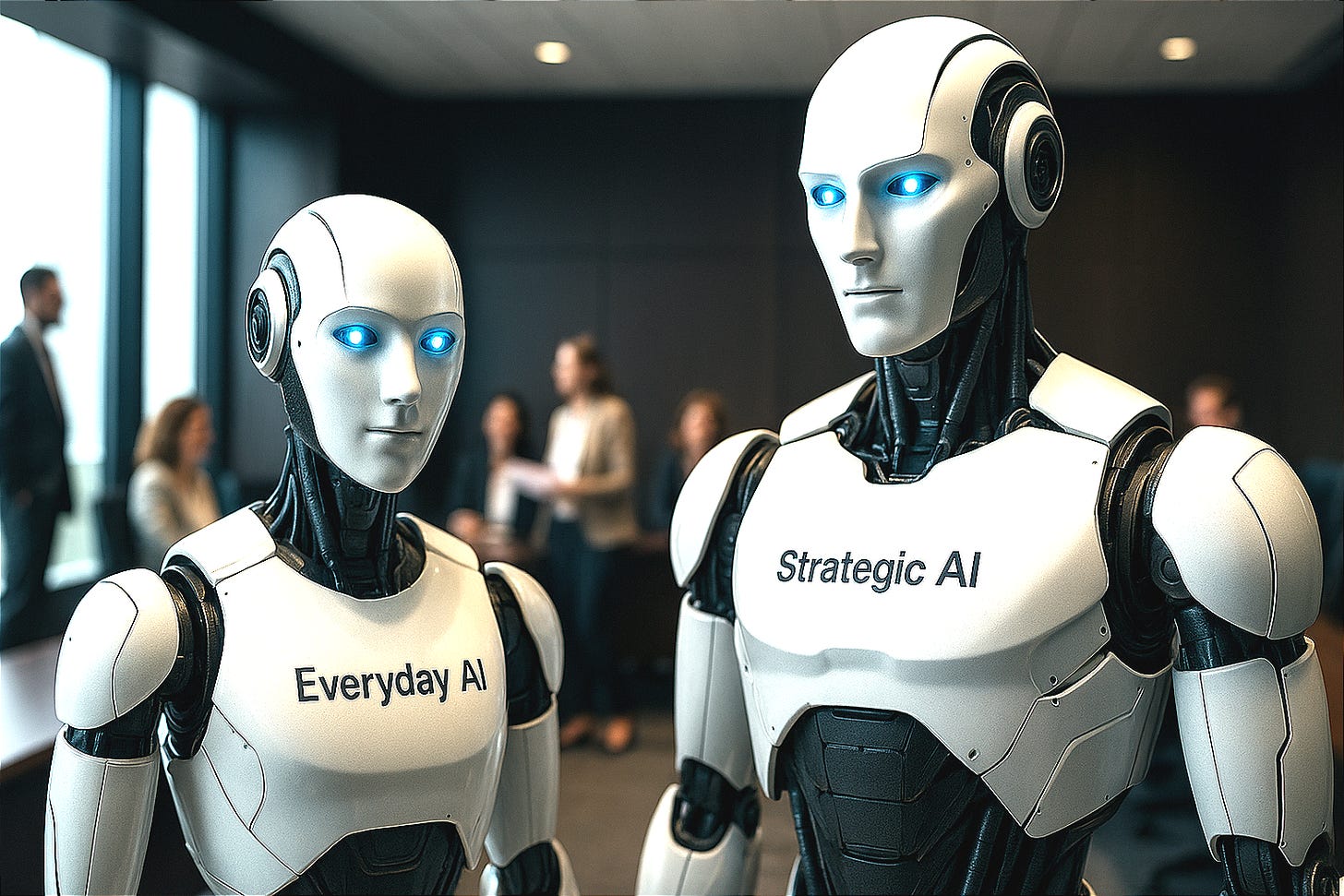Stop Hunting the “Killer App.” Start Shipping Everyday AI.
The fastest path to ROI—and a healthier, happier workforce—is pairing Everyday AI with Strategic AI as sister programs.
📌 THE POINT IS: Don’t just bet the farm on moonshot business cases for AI. Build a culture where potentially thousands of small, compounding AI wins free up time, fund the big bets, and enable real quality-of-life gains—including maybe even a path to the four-day week for some companies in the US!
Author’s Note: The day after I drafted this article, I listened to the Artificial Intelligence Show (Ep 165) and was pleased to hear the experts talking about this very topic. AI integration into your work environment will change how people work. Hearing them as well as quotes from NVIDIA’s Jensen Huang, who albeit is less bullish on the four-day workweek but still quite bullish on productivity gains and company’s being able to choose how to utilize them, I felt very excited to share my take on all of this with you!
Executives keep telling me that AI requires a use-case before they can get started on investments. I get it, you want that sweet ROI, but realistically, ROI on your AI investments will be realized through non-traditional mechanisms as we go forward. The data says durable value comes from a portfolio: pair Everyday AI (task-level copilots, workflow assistants, coding aides) with Strategic AI (new products, agentic systems, business model shifts). Leaders who balance both see results faster—and they keep them.¹²
“Companies that boost their learning capabilities with AI are significantly better equipped to handle uncertainty.” – MIT Sloan Management Review & BCG⁶
Why Everyday AI must sit beside Strategic AI
Generative AI’s macro potential is undeniable—McKinsey estimates $2.6–$4.4T in annual value and a 0.1–0.6% annual lift to labor productivity through 2040.¹ That value isn’t magic; it materializes when thousands of routine activities get faster, easier, and higher quality. Randomized and field studies back this up: GitHub Copilot users completed coding tasks 55.8% faster in a controlled trial,³ and a large-scale NBER study of 5,179 support agents found a 14% productivity gain on average—34% for novices—when using an AI assistant.⁴ Microsoft’s Work Trend Index echoes this pattern across knowledge work: early Copilot users were 29% faster across writing, summarizing, and searching; 70% reported higher productivity.⁵
“Only 22% of companies have advanced beyond proof-of-concept to generate some value—and only 4% are creating substantial value.” – BCG, Where’s the Value in AI?⁷
Translation: moonshots without a base of Everyday AI often stall overall AI adoption and culture change. Leaders in this field focus on core processes and people, then scale.⁷ Meanwhile, Gartner expects agentic AI to permeate software quickly—by 2028, 33% of enterprise apps will include agentic capabilities—so the operational backbone you build now will compound.⁹
We’re seeing this now in my world. Whether it’s Copilot entering Microsoft’s suite of tools more fully; Databrick AI/BI Genie and Mosaic AI; Snowflake’s Cortex AI; AgentForce in SalesForce; or Workday’s newest AI features…these capabilities are becoming table stakes in large, enterprise applications across the board.
Everyday AI lifts productivity and quality of life
The productivity story matters, but so does well-being. OECD evidence finds most employees using AI at work report better performance, job enjoyment, and improvements to mental and physical health.⁸ And when organizations reinvest time savings into better ways of working, the gains can support schedule innovations. In the UK’s landmark four-day week pilot (61 firms; ~2,900 workers), researchers reported revenue held steady (up 1.4% on average) during the six-month trial, while stress and burnout dropped and retention improved—many firms kept the policy.¹⁰ ¹¹
“Company revenue barely changed during the trial period—rising by 1.4% on average.” – Autonomy & university research team, UK pilot report¹⁰
What’s interesting about this is that they did this pilot before AI was really introduced into companies. We’re just now seeing models that are capable enough to be junior co-workers. Imagine the impact on revenue in the UK pilot with today’s tools. We could have seen a much greater than 1.4% lift on that same 4-day time period.
A brief, on-the-ground example
Inside my team, we’re building a chatbot agent tuned to our standards, accelerators, and “Golden Path” methods for data pipelines and curated models. In a Trusted Data Environment, this everyday assistant will onboard new developers, guide business data teams, and help contractors ship integrations the right way, faster. It won’t transform our whole business by itself, but it will accelerate everything else—shorter time-to-market for analytics and the next wave of Strategic AI implementations!
“Generative AI assistance disseminates the best practices of more able workers and helps newer workers move down the experience curve.” – Brynjolfsson, Li & Raymond, NBER⁴
The cool part is that we can roll out capabilities bit-by-bit to continuously show incremental value since this is a self-built, Everyday AI agent. It’s a digital co-worker that can be at everyone’s side when building data pipelines and data models. It will help us position our Trusted Data Environment as a rapidly growing platform.
Related whitepaper:
Make them sister initiatives: Everyday AI + Strategic AI
Here are some steps to take to get started and stay in check on both paths:
Stand up Everyday AI as a program with a product owner, budget, and backlog. Target the top 10–15 recurring tasks in each function (docs, meetings, search, coding, service). Prove time savings and quality deltas with before/after baselines (cycle time, defect rate, CSAT).³⁴⁵
Run Strategic AI in parallel with 1–3 high-value bets (e.g., agentic workflows, new AI-native features). Make sure executives are bought in and understand the commitment, but insist on milestones tied to measurable outcomes. Leaders that do this outperform.⁷
Invest in change management and learning loops. Train managers on “work redesign,” not just prompts, but keep the basics of prompt and context engineering at the forefront of your associate training programs. MIT SMR/BCG finds organizations that combine organizational learning with AI-specific learning are 1.6–2.2x better at navigating uncertainty.⁶
Measure and reinvest time. Redirect reclaimed hours to customer work and innovation that teams can actually deliver outside of just a couple-day hackathon setting. Where metrics hold—consider how you can give time back to associates in terms of extra, flexible time off, floating holidays, flex time for associates who perform work over weekends, or even if you’re bold, four-day workweek pilots in eligible teams.¹⁰ ¹¹
Strengthen the data backbone. Everyday AI without trusted, well-governed data is risk, not value. Often times this requires a whole different set of data hygiene controls, tools, and policies since this type of AI will often interact with your user-generated, office-document processes. Don’t skip out on making sure you have good guardrails setup here to minimize risk!
Ready the stack for agents. Gartner’s agentic wave is coming; design guardrails, identity, observability, and human-in-the-loop for any use cases now.⁹
Bottom line: Everyday AI compounds; Strategic AI differentiates. Together, they create the financial, cultural, and operational surface area to go faster and work better.
References
McKinsey Global Institute, “The economic potential of generative AI: The next productivity frontier.” https://www.mckinsey.com/capabilities/mckinsey-digital/our-insights/the-economic-potential-of-generative-ai-the-next-productivity-frontier (McKinsey & Company)
McKinsey Global Institute (PDF), “The economic potential of generative AI.” https://www.mckinsey.com/~/media/mckinsey/business%20functions/mckinsey%20digital/our%20insights/the%20economic%20potential%20of%20generative%20ai%20the%20next%20productivity%20frontier/the-economic-potential-of-generative-ai-the-next-productivity-frontier.pdf (McKinsey & Company)
GitHub (arXiv), “The Impact of AI on Developer Productivity: Evidence from GitHub Copilot.” https://arxiv.org/abs/2302.06590 (arXiv)
NBER Working Paper, “Generative AI at Work” (Brynjolfsson, Li, Raymond). https://www.nber.org/papers/w31161 and PDF https://www.nber.org/system/files/working_papers/w31161/w31161.pdf (NBER)
Microsoft Work Trend Index Special Report, “What Can Copilot’s Earliest Users Teach Us…?” https://www.microsoft.com/en-us/worklab/work-trend-index/copilots-earliest-users-teach-us-about-generative-ai-at-work (Microsoft)
MIT Sloan Management Review & BCG, “Learning to Manage Uncertainty, With AI.” https://sloanreview.mit.edu/projects/learning-to-manage-uncertainty-with-ai/ (MIT Sloan Management Review)
Boston Consulting Group, “Where’s the Value in AI?” https://www.bcg.com/publications/2024/wheres-value-in-ai (BCG)
OECD, “The impact of AI on productivity, distribution and growth” (2024). https://www.oecd.org/content/dam/oecd/en/publications/reports/2024/04/the-impact-of-artificial-intelligence-on-productivity-distribution-and-growth_d54e2842/8d900037-en.pdf (OECD)
Gartner, “Intelligent Agents in AI Really Can Work Alone. Here’s How.” https://www.gartner.com/en/articles/intelligent-agent-in-ai (Gartner)
Autonomy, “The Results Are In: The UK’s Four-Day Week Pilot” (full report PDF). https://autonomy.work/wp-content/uploads/2023/02/The-results-are-in-The-UKs-four-day-week-pilot.pdf (The Autonomy Institute)
University of Cambridge (Dept. of Sociology), “New results from the world’s largest trial of a four-day working week.” https://www.sociology.cam.ac.uk/news/new-results-worlds-largest-trial-four-day-working-week (sociology.cam.ac.uk)




